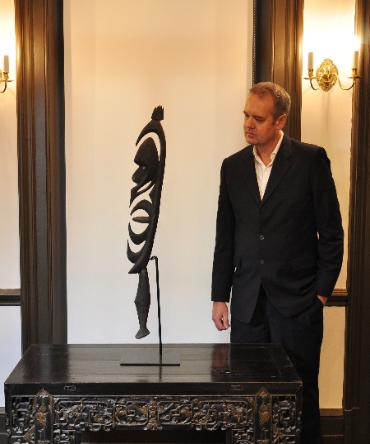Enquiry about object: 2183
Sepik Yipwon Spirit Figure
Yimam People, Korewari River Area, Papua New Guinea first half of the 20th century
height: 86cm (height with stand: 103cm), width: 14cm
Provenance
Francis de Sales McHugh Collection, and thence by descent, collected by de Sales McHugh in the first half of the 20th century.
This Yipwon spirit figure is from New Guinea’s Karawari River region. It is carved from a single piece of wood and is a highly stylised representation of a primordial hunting spirit in human form. The carver has simplified the human figure into a series of hook-like projections. The head has a beard that terminates in a sharp point. A head-covering rises over the head and this is surmounted by a tassel not unlike a rooster’s comb. The torso is marked out by curved, rib-like projections. The eyes are marked out on both sides by small cowrie shells embedded into the wood.
Larger examples of these spirit figures were kept in the men’s ceremonial house. Smaller examples were kept as personal amulets. Medium-sized examples such as that here were owned by individuals and taken on raids and animal hunts.
According to Kjellgren (2007, p. 58), ‘Admired by Western artists for their radical conception of the human form, the distinctive one-legged hook figures (Yipwon) of the Korewari River region caused a sensation when the first examples reached the West in the 1950s.’
Further according to Kjellgren, Yipwon figures were largely inanimate. But before a raid or a hunt, the man most closely associated with it would activate it by chewing a concoction of betel nut, ginger, a small amount of his own blood, and substances such as excrement derived from the intended victim or game. The chewed mixture was then applied to the figure, which was also rubbed with stinging nettles to make it supernaturally ‘hot’. Spiritual approval of the planned attack or hunt was indicated by the figure turning to the direction of the target village or hunting area. If the attack or hunt was successful, then gratitude would be shown by smearing the figure with the victim or prey’s blood. Yipwon figures that did not prove useful were discarded.
The item was collected in the first half of the twentieth century by Francis de Sales McHugh, who was born in Queensland, Australia in 1896, and who worked in New Guinea as a foreman of works for the Queensland Department of Posts and Telegraphs building regional post offices. It was during this time that he collected this item. The figure passed to his daughter who now lives in the UK, and in whose possession it had remained since.
The figure is free of losses or repairs and has a dark patina. It has a custom-made black metal stand.
References
Bounoure, V., Vision d’Oceanie, Musée Dapper, 1992.
Duuren, D. V., Oceania at the Tropenmuseum, KIT Publishers, 2011.
Herreman, F. (ed.), Oceanie: Tekens van Riten, Symbolen van Gezag, Wereldmuseum/Mercatorfonds, 2009.
Kaeppler, A. L., C. Kaufmann & D. Newton, Oceanic Art, Abrams, 1997.
Kjellgren, E., Oceania: Art of the Pacific Islands in the Metropolitan Museum or Art, Yale University Press, 2007.
Meyer, A. J. P., Oceanic Art, Könemann, 1995.





